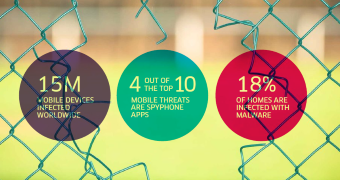In the first half of 2014, the infection rate for mobile devices grew by 17%, which is almost as much as the increase for the entire year 2013, when 20% was recorded.
According to a study from Kindsight Security Labs of Alcatel-Lucent, with data pulled from their sensors, 60% of the infected devices run Android operating system, and less than 1% rely on iOS, Blackberry, Symbian and Windows.
Based on telemetric information, the researchers estimate that about 15 million devices are currently infected worldwide. However, this number could be conservative because it does not include data from areas where infection rates are known to be higher, such as China and Russia, where Alcatel-Lucent sensors are not available.
Furthermore, information from the International Telecommunication Union (ITU) says that there are 2.3 billion smartphones in the world.
Spyware is the most present form of malware on mobile
The study shows that the most prevalent form of malware is spyware, with four new entries being added to the top 20 list of malware. This type of threat is used for tracking device location, spying on incoming and outgoing calls and text messages, as well as tracking web browsing activity.
On Android, at the top of the list is a variant of a Trojan called Coogos, affecting more than 35% of the devices monitored by the security firm. It appears that it sends information from the phone to a server located in China.
Researchers say that, in the beginning, it was distributed as a wallpaper, but a newer version is packaged as a game.
In second place, accounting for little over 30% of the infections, is Uapush Trojan, which displays advertisements on the device but also includes functions for stealing information such as call history and contacts, and for sending text messages (probably to premium-rate services); its command and control server has also been traced to China.
Residential infection rate sees an upward trend, too
The company also included information about residential infection rate in fixed broadband networks, which doubled since December 2013 (9%) to 18% at the end of June 2014; the increase is attributed to moderate-threat-level “adware” infections.
According to Kindsight’s three-month detection period, the most prevalent threats on users' home devices are adware programs that generally install toolbars and display advertisements on the affected system.
However, the top threats are in a different class of malware and pose a much greater risk as they are equipped with functions that can lead to identity theft.
At the top of the list is ZeroAccess Trojan (11.13% of infections), mostly used to funnel in other threats that are generally used for large scale ad-click fraud.
Carberp, the infamous banking Trojan, is also on the list. It accounts for 6.33% of the infections and is designed specifically for stealing banking information that is uploaded to a remote server.

 14 DAY TRIAL //
14 DAY TRIAL //